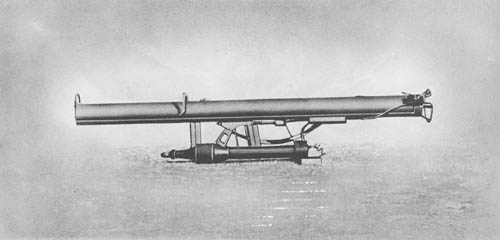
The German antitank rocket launcher (Racketenpanzerbüchse 43), one of which was recently captured in Italy, is a comparatively new design, similar in appearance and operation to the American “Bazooka.” The German weapon is of larger caliber and is heavier than its American counterpart. It employs an 8.8 cm rocket (3.5 inches) weighing 7.16 pounds; the 2.36 inch American rocket, M6A3, weighs 3.5 pounds. The launcher, which is shoulder fired and handled by a two-man team, has a maximum range of 132 yards and a muzzle velocity of 346 f/s. It is 64.5 inches long, has an outside diameter of 3.7 inches; weighs 20.5 pounds; and is equipped with a foresight, a rearsight, and a carrying sling. An improved model with a face shield is known as 8.8 cm R PzB54.
After insertion into the tube, the round is prevented from slipping back by a retaining catch and from slipping forward by a spring-loaded plunger which engages the front edge of the tail unit. An electric socket inside a housing is located at the rear left side of the tube. The firing mechanism, which is also situated underneath the tube, consists of a spring-loaded rod (which is drawn forward into a compressed position when the piece is cocked) and a cylindrical component which appears to contain a magnetized rod and a coil. Two wires attached to this current-producing component connect with the socket on the launcher and with the plunger which contacts the tail of the projectile. When the trigger is pressed, the magnetized rod under the action of the compressed spring passes through the coil generating a current which is transmitted to the sparking element of the propellant igniting it.
The projectile, which is of the hollow charge type, has a nose fuze; the motor tube contains the propellant; and the tail is of the circular-fin type.